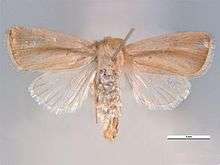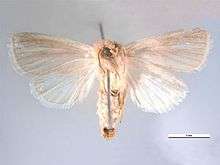Sesamia inferens
| Asiatic pink stem borer | |
|---|---|
 | |
| Dorsal view | |
 | |
| Ventral view | |
| Scientific classification | |
| Kingdom: | Animalia |
| Phylum: | Arthropoda |
| Class: | Insecta |
| Order: | Lepidoptera |
| Family: | Noctuidae |
| Genus: | Sesamia |
| Species: | S. inferens |
| Binomial name | |
| Sesamia inferens (Walker, 1856)[1] | |
| Synonyms | |
| |
The Asiatic pink stem borer, (Sesamia inferens), also known by names such as Gramineous stem borer, Pink borer, Pink rice borer, Pink rice stem borer, Pink stem borer, Pink stem borer, Purple borer, Purple stem borer or Purplish stem borer, is a moth of the Noctuidae family. It is found from Pakistan, India, Sri Lanka, Myanmar to Japan and the Solomon Islands.[2] A polyphagous species, it is a major pest in many worldwide crops.[3][4]
Description
Wingspan is about 28mm. Hind wings with veins 3 and 4 from arise from the cell. Antennae of male ciliated and simple in female. Body ochreous in color. Fore wings with a red-brown suffusion along median nervure and veins 2 to 5. A sub-marginal dark line present. Cilia paler in color. Hind wings are whitish.[5]
Larva smooth and shiny and lack obvious hairs or markings. Color variable but usually creamy-white with a distinctive pink suffusion. The head and prothoracic shield are brown. The dorsal part of the last abdominal segment bearing the anus is yellowish-brown. Mature larvae are between 30-40 mm long, pink with buff and pink dorsal markings and a brown head. Pupae are up to about 18 mm long, brown to yellowish-brown with a wrinkled frontal region of the head and cremaster with four large and two small spines.[6]
Ecology
The larvae mostly feed on Gramineae species, including Coix, Echinochloa, Oryza, Panicum, Saccharum, Setaria, Triticum, Zea and Zizania. Many of the food plants are of economic importance.[7]
Symptoms
Caterpillars mainly bore into rice stem or base of the panicle. After infection, stem becomes wilt causing deadheart. Panicle attack leads to panicle to be cut leading to state called whitehead. Symptoms are mostly similar to other stem borers and hence closer look required to control the attack.[8]
Control
Mechanical controlling using hand picking and pheromone traps are used. Cultural practices like crop rotation mechanisms, reducing water levels are also used in controlling. Natural enemies such as parasitoides are very effective and nature loving controlling measures. Techinid fly Sturmiopsis inferens also once used, but now non-effective due to their low abundance.[8] In chemical control, BHC, DDT, fenthion, fenitrothion, quinalphos, phosphamidon sprays and granules of lindane are used. Eggs can eliminate by introducing Trichogramma minutum and Telenomeus species. Apanteles flavipes, Bracon chinensis and Sturmiopsis inferens are effective against caterpillars, whereas Xanthopinpla species and Tetrastichus aygari are used in pupal stages.[9]
References
- ↑ Sesamia at funet
- ↑ PaDIL
- ↑ "Sesamia inferens". iaszoology.com. Retrieved 4 August 2016.
- ↑ "Sesamia inferens (Walker)". ICAR-National Bureau of Agricultural Insect Resources. Retrieved 4 August 2016.
- ↑ Hampson G. F. (1892). "The Fauna Of British India Including Ceylon And Burma Moths Vol-ii". Digital Library of India. p. 558. Retrieved 4 July 2016.
- ↑ "African Pink Stalkborer". BioNET-EAFRINET. Retrieved 4 August 2016.
- ↑ The Moths of Borneo
- 1 2 "purple stem borer (Sesamia inferens)". Plantwise Technical Factsheet. Retrieved 4 August 2016.
- ↑ "Pink Stem Borer (Sesamia inference): Nature, Life Cycle and Control". YourArticleLibrary.com. Retrieved 4 August 2016.
External links
- and Insecticide Resistance of Sesamia inferens
- Notes on the Bionomics of the Pink Stem Borer Sesamia inferens
- Natural Incidence of Sesamia inferens Walker, in Sugarcane Germplasm
- Population dynamics of Sesamia inferens on transgenic rice expressing Cry1Ac and CpTI in southern China
- Evaluating the non-rice host plant species of Sesamia inferens (Lepidoptera: Noctuidae) as natural refuges
- Incidence of the Pink Noctuid Stem Borer, Sesamia inferens (Walker), on Wheat under Two Tillage Conditions and Three Sowing Dates in North-western Plains
- Evaluate efficacy of different insecticides against Sesamia inferens
- Semiochemicals of Sesamia inferens
- Genetics of resistance to Sesamia inferens infestation and its correlation with yield in maize
- Screen of Bacillus thuringiensis toxins for transgenic rice
- Binding Site Concentration Explains the Differential Susceptibility of Chilo suppressalis and Sesamia inferens to Cry1A-Producing Rice
- Differential preference of maize genotypes to Sesamia inferens
- The Complete Mitochondrial Genome of the Pink Stem Borer, Sesamia inferens, in Comparison with Four Other Noctuid Moths.
- Cold tolerance characteristics and overwintering strategy of sesamia inferans
- Growth Stage Preference of Pink Stem Borer Sesamia Inferens
- Study the egg laying pattern of Sesamia inferens
- First Microsatellites From Sesamia inferens
| Wikimedia Commons has media related to Sesamia inferens. |
| Wikispecies has information related to: Sesamia inferens |